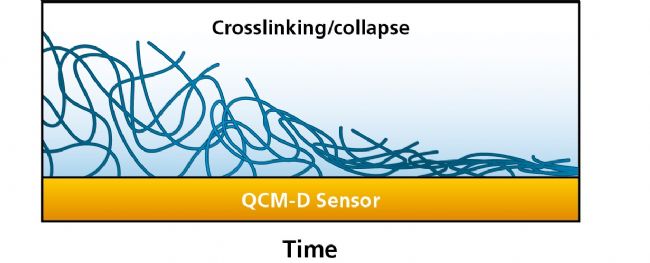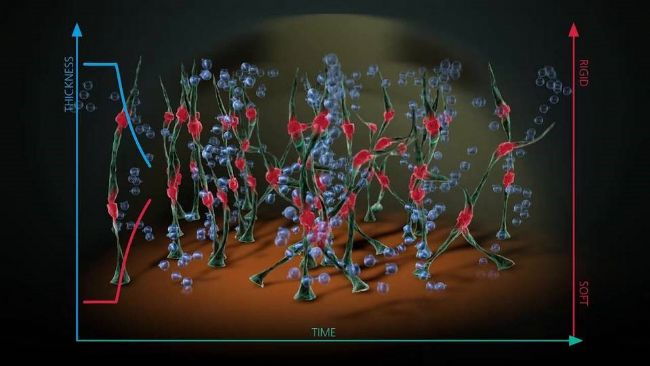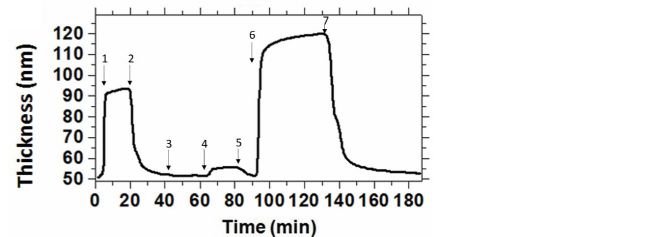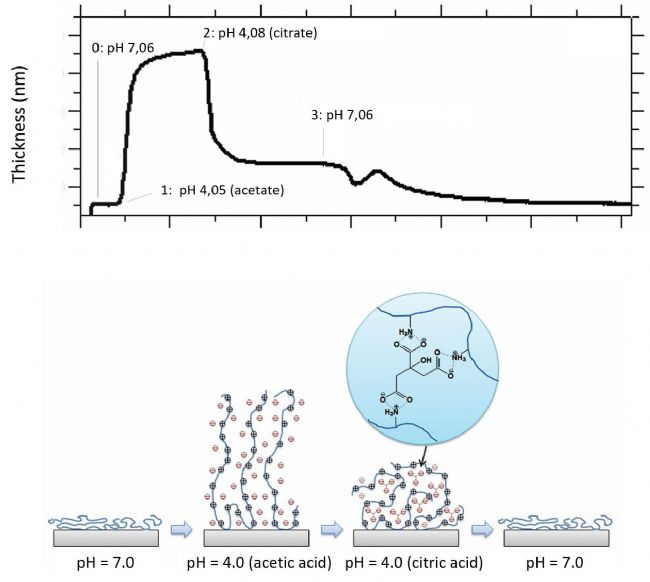How to detect cross-linking and collapse using QCM-D

Biocompatibility, antimicrobial properties, and drug delivery capabilities are key performance indicators for certain materials and products. These performance indicators can also be achieved by ingenious material design for polymer brushes, polyelectrolyte multilayer films or hydrogels. An important parameter in the adjustment of the interfacial properties of these materials is the molecular layer conformation such as cross-linking and hydration.
Effect of polymer conformation on the surface on the interface properties <br> Polymers with different conformations and polyelectrolytes such as polymer brushes, polyelectrolyte multilayer films or hydrogels, ie crosslinked polymer networks, need to be adjusted in many interfaces. Features are used in applications that promote some interaction with the surrounding environment. Protein adsorption, prevention of bacterial adhesion and drug release are some of the typical applications.
Due to the different molecular conformations at the interface, polymer brushes, polyelectrolyte multilayer films or hydrogels are more or less hydrated and viscoelastic. Molecular conformation has a major impact on the properties of the interface, which in turn affects its interaction with the environment.
In order to adjust the material to obtain its desired interaction with the environment, such as promoting protein adsorption, preventing bacterial adhesion or releasing drugs in a stimulating manner, we need to characterize the conformation behavior of the surface interface polymer. The QCM-D technique, which is sensitive to surface changes, is a means of detection that can be used to evaluate the conformation of molecular layers.
Monitoring the water release and cross-linking of thin films <br> To study and orient the surface interface properties of molecular films, it is important to characterize and understand the conformational behaviors such as the degree of hydration, the transition from hydration to collapse or cross-linking, and vice versa. Also. In Figure 1, swelling and collapsing of polymer brushes and other films can be characterized by QCM-D and other techniques that sense water adsorption and release by detecting mass changes.

Figure 1. From left to right, there is shown how the thick and high in releasing water of hydration on the surface of the film and collapses into a thin film.

Examples of collapse and cross-linking <br> As an example of the transition between hydrated and dehydrated states, let us look at the expansion and collapse of polymer brushes made from chitosan [1]. The conformation of the chitosan molecular brush depends on the pH and the size of the counter anion. At low pH, the polymer brush is water soluble, and when the pH is greater than 6.5, it is a collapsed strand and is insoluble in water.
- The polymer was first coated on the QCM-D chip.
- Then, the polymer brush was exposed to different pH values ​​and a counter anionic solution to observe the effect on the film thickness.
- The results in Figure 2 show that the molecular layer swells at high pH and collapses at low pH.

Figure 2 1. Thickness of the chitosan layer when exposed to different pH and counter anionic solutions.
An anion can also be used to crosslink the polymer brush [1]. As shown in Fig. 3, when the acetate anion is replaced with a citrate anion, it forms an ionic crosslink with the ammonium cation on the polymer brush, which causes collapse of the polymer brush.

Figure 3 1 . (Upper) Thickness of the chitosan molecular brush when exposed to different solution pH and counter ions. Schematic diagram of the structure of the (lower) chitosan molecular brush as a function of pH and counterion type.
These experimental results show how changes in pH and counterion cause film collapse and cross-linking. The results of the study can help us understand the effects of environmental pH and counterion size on the polymer brush conformation.
For more information on how to characterize the swelling, cross-linking and collapse of polymer layers, please download the app summary in the appendix.
Nutrition Enhancers Xylo-Oligosaccharid Syrup,High Nutrition Enhancers,High Purity Xylo-Oligosaccharide
Qingdao Bailong Huichuang Bio-tech Co., Ltd. , https://www.sdblcycn.com